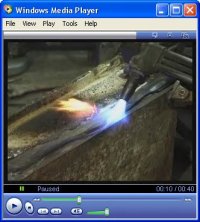 |
Conservation of Cast & Wrought Iron |
  |
|
|
6 Repair techniques - Hot
| Hot processes are used in forming, joining and cutting iron, but are often
prohibited in historic buildings due to fire risk, or are allowed only on the
basis of a daily ‘hot works permit’ where no other process can be substituted.
Coke-fired hearths were the traditional means of heating. On sites small
portable hearths were employed for heating rivets, etc. and hearths are still
widely used in workshops for general forgework. Nowadays three additional
methods of heating are commonly in use: |
| Fuel gas and air - Butane or propane stored in portable bottles mixes with air
at a torch to provide a flame at several hundred degrees centigrade. Used for
low temperature operations such as heating components to separate them,
softening paint, and soft soldering. see below) |
| Fuel gas and oxygen - Propane or acetylene and oxygen stored in heavy bottles
mix at the nozzle of a blowpipe to produce a flame around 3,000 degrees
centigrade. Used for forming metals, separating components, flame cleaning,
silver-soldering, brazing and fusion welding. (see below) These gases can also
be used for cutting thick sections of wrought iron and steel where excess oxygen
is used to blow away white-hot metal (flame cutting). Use of gases on site is
dangerous due to their flammability and naked flame, and restricted by the size
and weight of bottles. |
| Electric arc - The low voltage/high current output from a transformer provides
a continuous spark or arc between the workpiece and an electrode at around 3,000
degrees centigrade producing an instant localised molten pool. Used mainly for
welding processes, principally MMA & MIG (see below). Electric arc welding is
not recommended for repairs to cast iron due to the risk of thermal-shock damage
to the brittle material. |
 |
Soldering & welding processes - Iron oxidises when heated which prevents
joining, or reduces the strength of the joint. A flux or inert gas shield must
therefore be introduced to prevent oxidation by providing reducing conditions.
- Soft Soldering - Soft solder is an alloy of tin and lead (sometimes with traces
of antimony) which melts around 200 degrees centigrade. Surfaces to be joined
are cleaned, protected with a liquid or paste flux, heated by gas-air flame or
electric soldering iron, and wire or stick solder melted into the joint. Widely
used in joining copper, brass and lead for non-structural applications.
- Brazing or hard soldering - Surfaces to be joined are cleaned, fluxed, and
heated by oxy-propane flame to around 600 degrees centigrade. A bronze filler
wire (spelter) is melted into the joint, drawn in by capillary action. Spelter
containing silver (silver solder) melts at a lower temperature providing a
weaker joint. Suitable for non-structural applications on thin cast and wrought
iron sections, but cast iron must be heated and cooled slowly to minimise the
risk of cracking.
- Gas fusion welding - Components are heated by oxy-acetylene flame to their
melting temperature creating a localised weld-pool into which a filler rod of
the same metal is melted. Suitable for the structural repair of cast iron which
must be pre and post heated to minimise thermal shock.
- Manual Metal Arc welding (MMA or ‘stick’ welding) - An electric arc between a
consumable electrode and the work-piece forms a small weld pool in which the
components fuse. Oxidation is prevented by the vaporisation of a flux coating
around the electrode.
- MIG welding (Metal Inert Gas) - As MMA welding but the weld-pool is protected
by a shield of argon, and the filler-wire electrode is automatically fed into it
by a current-sensed servo-system. Suitable for welding wrought iron, but neither
MMA nor MIG welding are recommended for repairing cast iron due to the risk of
thermal shock causing cracks around the weld.
- Fire or forge welding - Two pieces of wrought iron will readily fuse together
if heated in a hearth to white heat and hammered together. A well-executed forge
weld should achieve about 80% of the original metal strength, and is recommended
as an appropriate traditional process for repairing wrought ironwork.
|
 |
Hot set riveting - This is the commonest traditional method of joining wrought
iron components in structural and decorative applications, and should NOT be
replaced by welding. Rivets are entered red-hot into prepared holes, the head
retained by a hand-held gun or jack, (‘a holder-up’) and the tail forged down to
fill the hole, and grip the components. Grip is further tightened by the rivet
shrinking, resulting in a strong, watertight joint. Rivet heads are commonly
spherical (round-head), conical (snap-head), or flush with the surface
(counter-sunk). Small rivets are set by hand, larger ones by pneumatic or
hydraulic tools which allow large numbers of rivets to be set quickly.
Removal of rivets must be undertaken with care to avoid damaging plates and
holes. Heads may be ground off, shanks drilled and the rivet punched out. A
quicker (traditional) method is to shear off the head with a rivet-buster, a
long pneumatic gun operated by two men. Its chisel is placed under the
rivet-head to shear it off, and a punch in the same gun is used to drive out the
shank. Appropriate safety precautions must be taken. |
|
|